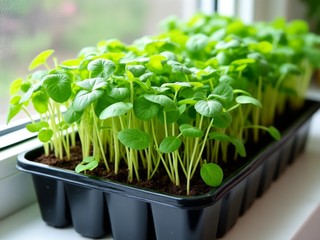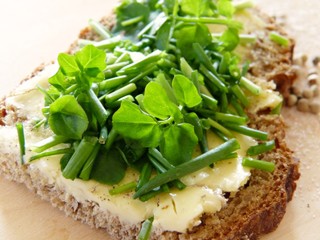How to care for watercress (indoors)

Watercress (nasturtium officinale), a water-loving perennial, is easy to grow but requires proper care to thrive.
Basic care
Focus on these key areas to keep your watercress thriving:
- Moisture: Keep the growing medium consistently moist.
- Adequate light: ~4 hours of indirect sunlight per day.
- Fertilization: Lightly apply water-soluble fertilizer every few weeks.
- Pruning: Prune plants back to about 4 inches to encourage bushier growth.
For more practical information on how to manage each of these areas, continue reading below.
Watering and moisture control
Watercress thrives in moist, waterlogged conditions. Here’s a checklist to follow:
- Check moisture daily: The soil should feel damp, like a wrung-out sponge.
- Use bottom watering: This keeps moisture consistent without soaking the soil.
- Change water every 1–2 days: Prevents stagnation and algae growth.
If you are growing watercress hydroponically, use an air stone or small pump to keep water moving and oxygenated.
Light requirements
Watercress needs the following light conditions to thrive:
- Indirect sunlight: ~4 hours per day.
- Artificial lighting: 8–12 hours of grow lights if natural light is insufficient.
- Optimal temperature: Keep temperatures between 50–60°F.
- Rotating: Rotate the plant every few days to ensure even growth.
Place your watercress near an east- or north-facing window to provide the ideal amount of indirect sunlight without exposing it to harsh afternoon rays that could wilt the leaves.
If you don’t have enough natural light, position LED or fluorescent grow lights 6–12 inches above the plant, and keep them on for 8–12 hours a day.
Fertilizing
Fertilizing watercress is optional but can help boost growth. If you choose to fertilize, here’s what to know:
- Type of fertilizer: Use a water-soluble fertilizer, applied lightly.
- Frequency: Fertilize every few weeks.
- Dilution: Always dilute the fertilizer to less than half the recommended strength.
Watercress doesn’t require heavy fertilization, and too much can do more harm than good. Stick to a light application schedule, especially if you’re growing in nutrient-rich water or using a hydroponic system.

Neptune’s Harvest seaweed fertilizer (36 oz)
- Made from seaweed (ascophyllum nodosum)
- Sourced from north Atlantic ocean
- Formulation is designed to be diluted and used immediately
Pruning
Regular pruning keeps watercress productive and helps it maintain a compact shape. It encourages fuller growth, prevents legginess, and promotes new shoots.
You should prune watercress every few weeks or when it reaches 4–6 inches in height.
- Use clean, sharp shears or pinch the tips with your fingers.
- Trim plants back to about 4 inches tall.
- Focus on removing leggy, overgrown stems to encourage bushier growth.
For a detailed guide on pruning, check out our pruning guide.
Common issues & how to fix
Even though watercress is generally easy to grow, beginners may run into a few common problems. Here’s how to identify and address them:
Yellowing leaves (nutrient deficiency)
-
Cause: A lack of nitrogen or poor water quality.
-
Solution: Use a very dilute, water-soluble fertilizer to add nitrogen. If using hydroponics, check and adjust pH levels (6.5–7.5 is ideal). Ensure your water source isn’t too hard or alkaline.
Stunted growth
-
Cause: Inadequate light or poor air circulation.
-
Solution: Ensure your watercress gets 4 hours of indirect sunlight or 8–12 hours of grow lights. Improve airflow by avoiding overly crowded areas.
Water stagnation (slimy roots or foul odor)
- Solution: Refresh water every 1–2 days and clean containers regularly. In hydroponic systems, use an air stone to keep water moving.
Pests (aphids, spider mites, whiteflies)
- Solution: Check leaves for pests regularly. Use mild insecticidal soap or water with a few drops of dish soap to clean the leaves. Introduce natural predators like ladybugs if needed.
Leggy growth (poor light)
- Solution: Increase light exposure. Move the plant closer to a window or use artificial lights for more hours. Prune leggy growth to encourage a bushier shape.

Mold and algae growth
-
Cause: Too much moisture or poor air circulation.
-
Solution: Improve air circulation with a small fan, and change water frequently to prevent algae buildup. If mold forms on the soil, scrape it off and replace the top layer.
If you haven’t already, be sure to check out our other watercress guides:


